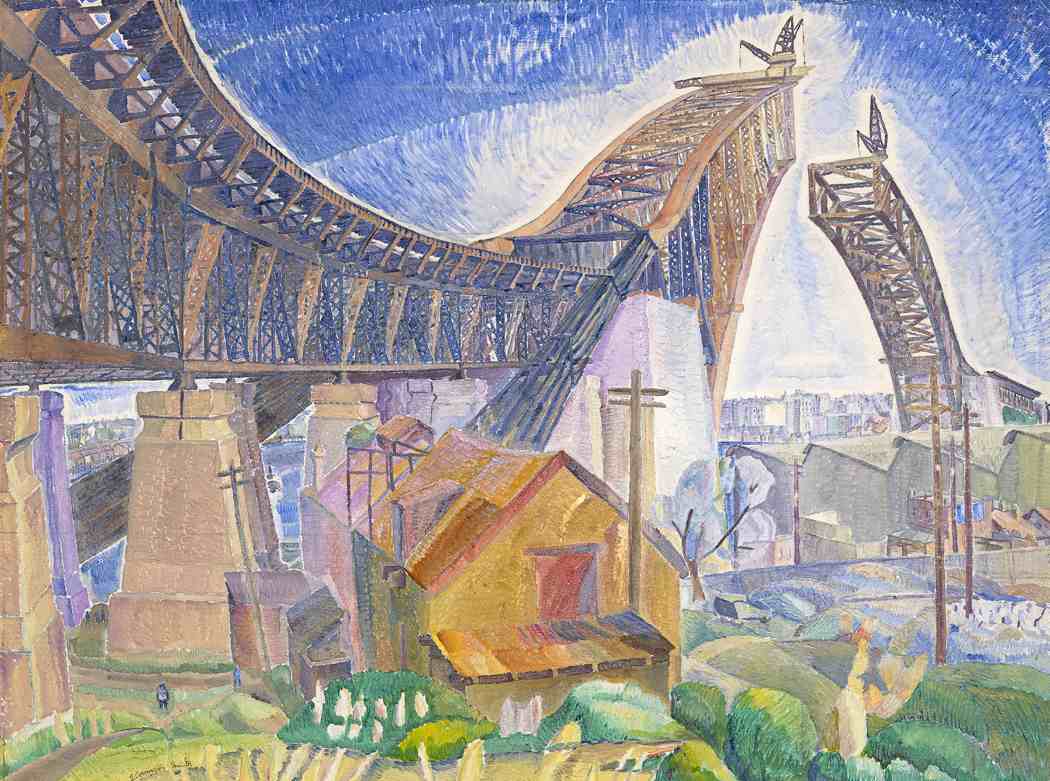Sydney Moderns
All-star Aussie artists chart the rise of local modernism.
Overview
The Latin motto of the University of Sydney is pretty stark about the size of the chip on its shoulder. “Sidere mens eadem mutato.” Meaning, roughly, “the same minds under a new set of stars”. That is, "we’re as good as all those other European universities". Sydney Moderns charts a similar path through the history of Sydney artists who returned from early 20th century jaunts in Europe with the influence of the big, overseas art movements of the day, like Cubism or Impressionism. These artists applied new techniques under Sydney University’s different stars. And the results make for an interesting take on Sydney in the early 20th century.
There are some obvious European connections, both modern and less so. Jesse Traill’s Piranesi-like etchings of the Harbour Bridge under construction are especially breathtaking in Sydney Bridge IV — the ants’ progress, Antonio Dattilo-Rubbo’s Pea gathering (Kurrajong Heights) seems to obviously owe quite a lot to Millet’s the Gleaners and Frank Hinder’s Aircraft shadow from searchlight also shows the bombastic influence of the motion-loving Futurists.
It's an important exhibition, full of masterful art that gives you windows into a Sydney of the 20s and 30s. But it also leans heavily on the Art Gallery of NSW’s own collections, almost to the point where you feel like “Grace Cossington Smith and Friends” might have given you a better idea of what the exhibition has to offer. There’s nothing wrong with this in itself. Grace Cossington Smith was a powerful artist, with a sharp eye and a profound grasp of human detail, but, at $15 a ticket, she’s also a regular you can ordinarily see on display for free in the Gallery collection. Only the sheer size of this exhibition eventually overwhelms this sudden sense of Art Gallery paywall.
For a show about the inter-war years and the influence of European painters, Sydney Moderns lacks a lot of information about the decade and influences its painters were working in. There are no photos of the European paintings whose influence was meant to be so keenly in this artwork (not even the constantly-mentioned Cezanne, so loved by Roland Wakelin) and there’s no photos of the actual places depicted, either. The fact that the majority of the art is by women is no small thing though, in this period barely past first-wave feminism.
And it’s great art. Margaret Preston’s Implement Blue picks out charged, Art Deco greys and blues, Roy de Maistre’s experimentations with the idea of "harmonies of colour" (mapping colours to a piano keyboard and combining them into “harmonious” combinations) makes for some surprisingly strong abstract composition in Arrested phrase from Beethoven’s Ninth Symphony in red major, Thea Proctor produces electric aristocrats of leisure and the Grosvenor School’s linocuts own sharp colours, lines and a pretty sharply clear inflience from Japan (as well as Claude Flight).
This really is an all star show. Most rooms are dominated by powerful art, from a period where Sydney was coming to terms with a changing world and changing artistic landscape. It’s just hard to escape feeling, especially in its opening room of Harbour Bridge art, that a lot of this is something we’ve seen before.
Image: The bridge in curve by Grace Cossington Smith. National Gallery of Victoria. © Estate of Grace Cossington Smith.





